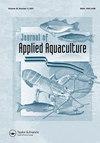Biofloc technology application in Nile tilapia ( Oreochromis niloticus , L.) hatcheries: effect on the reproductive performance, offspring quality, growth performance, and physiological parameters of fry
IF 0.8
Q3 FISHERIES
引用次数: 0
Abstract
ABSTRACTThis study evaluated the potential of applying biofloc technology (BFT) in Nile tilapia (Oreochromis niloticus) hatcheries. The first experiment was conducted to determine the effect of maintaining tilapia broodstock in BFT system in terms of reproductive performance and offspring quality as compared with the conventional clear-water system. A total of 45-tilapia broodstock were reared for 2 months in each treatment. Females at advanced maturation were transferred to four spawning tanks (800 L) at a density of eight individuals per tank (3:1 female:male sex ratio). Two tanks were assigned to each of the two treatments (BFT and control). Reproduction took place over the course of 2 months, with all females being inspected weekly to verify the presence of eggs. The second trial (43 days) analyzed the effect of BFT system on growth performance, feed utilization, digestive enzymes activity, and antioxidant status in the early fry stages. A total of 540 larvae (8.7 ± 0.7 mg) were assigned to six glass aquariums (60 L capacity). One experimental group was reared using a BFT system with daily sugar addition at a C/N ratio of 15/1, in comparison to a control group reared in clear water. Fish were fed commercial pellets three times a day at various feeding ratios (6–9% of the fish body weight). The fecundity of tilapia, hatching rate, egg and larval size, and larval resistance to stress tests presented no significant differences among treatments (P > .05). After 20 days of larval rearing, the daily weight gain was 29% higher in BFT fish as compared to the control treatment. The BFT system had better feed conversion ratio than control treatment. The larvae reared in BFT system had significantly higher alpha-amylase and catalase activities than control (P < .05). Overall, these results suggest that the BFT system can be used in tilapia hatcheries for broodstock rearing without negative effects on reproductive performance. The better growth performances of larvae reared in BFT treatment justified the application of this system during nursery phase.KEYWORDS: Nile tilapiabioflocreproductionlarval qualityenzyme activity AcknowledgmentsThe authors would like to thank Ms Ferhane Djamila, the director of the marine fish farming experimental station (Bousmail, Algeria) to facilitate the conduct of experiments.Disclosure statementNo potential conflict of interest was reported by the author(s).Additional informationFundingThe author(s) reported that there is no funding associated with the work featured in this article.生物絮团技术在尼罗罗非鱼(Oreochromis niloticus, L.)孵化场的应用:对鱼苗繁殖性能、子代品质、生长性能和生理参数的影响
摘要本研究评价了生物絮团技术在尼罗罗非鱼(Oreochromis niloticus)孵化场的应用潜力。第一个试验旨在确定在BFT系统中维持罗非鱼亲鱼在繁殖性能和后代质量方面的效果,并与常规清水系统进行比较。每个处理共饲养45尾罗非鱼2个月。将成熟期较晚的雌鱼转移到4个800 L的产卵池中,每池8只(雌雄比3:1)。两种处理(BFT和对照组)各分配两个水箱。繁殖过程持续了2个月,所有的雌性每周都要接受检查,以确认卵子的存在。第2期试验(43 d)分析BFT体系对苗期早期生长性能、饲料利用率、消化酶活性和抗氧化状态的影响。将540只幼鱼(8.7±0.7 mg)分养在6个容量为60 L的玻璃水族箱中。试验组饲喂每日添加糖的BFT体系,碳氮比为15/1,对照组饲喂清水饲养。每日三次按不同投喂比例(鱼体重的6-9%)投喂商业颗粒。不同处理罗非鱼的繁殖力、孵化率、卵和幼虫大小以及对应激试验的抗性均无显著差异(P > 0.05)。幼虫饲养20天后,BFT鱼的日增重比对照处理高29%。BFT系统的饲料转化率高于对照处理。BFT体系饲养的幼鱼α -淀粉酶和过氧化氢酶活性显著高于对照(P < 0.05)。综上所述,BFT系统可用于罗非鱼孵化场养殖,不会对繁殖性能产生负面影响。在BFT处理下饲养的幼虫生长性能较好,证明了该体系在苗期的应用。作者感谢阿尔及利亚Bousmail海鱼养殖实验站主任Ferhane Djamila女士为实验的开展提供了便利。披露声明作者未报告潜在的利益冲突。其他信息资金作者报告说,没有与本文所述工作相关的资金。
本文章由计算机程序翻译,如有差异,请以英文原文为准。
求助全文
约1分钟内获得全文
求助全文
来源期刊

Journal of Applied Aquaculture
Environmental Science-Ecology
CiteScore
3.20
自引率
0.00%
发文量
38
期刊介绍:
The Journal of Applied Aquaculture is a platform for the sharing of practical information needed by researchers to meet the needs of investors, farm managers, extension agents and policy makers working to adapt aquaculture theory to achieve economic and food security objectives in the real world. The journal emphasizes multi-disciplinary research and case studies that propose financially and logistically viable solutions to observable problems.
 求助内容:
求助内容: 应助结果提醒方式:
应助结果提醒方式:


